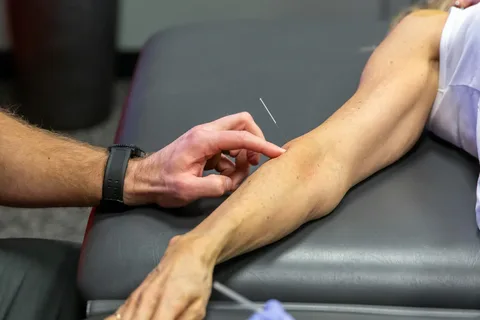
Acupuncture treatment for tennis elbow (lateral epicondylitis) primarily aims to relax muscles and tendons and relieve pain. Stimulating local acupuncture points (such as Quchi, Shousanli, and Ashi) improves circulation and reduces inflammation and muscle tension. Treatments are typically performed two to three times per week, along with rest and rehabilitation exercises. Most patients experience significant improvement in symptoms within four to six weeks.
1. The working principle of acupuncture treatment
- Promote local blood circulation: Acupuncture can dilate blood vessels, increase blood flow to the affected area, accelerate the excretion of metabolic waste, and relieve inflammation by stimulating acupuncture points.1.
- Regulate neuromuscular function: Acupuncture can inhibit the transmission of pain signals, reduce local nerve sensitivity, and relax over-tense wrist extensor muscles.2.
- Stimulate self-healing ability: activate the body’s repair mechanism through acupoint stimulation and promote the repair of tendon tissue.3.
2. Commonly used acupoints and operations
- Main acupoints1.
- Ashi Point (pain point): Directly acupuncture the area where the pain is most obvious to quickly relieve local symptoms.
- Quchi point (outer end of the elbow creases when the elbow is flexed): regulates Qi and blood in the upper limbs and relieves forearm muscle spasm.
- Shousanli point (outside of the forearm, 2 inches above the line connecting Yangxi and Quchi): dredges Qi through the hand Yangming meridian and improves elbow and wrist function.
2. Acupoint combination2.
- Pain radiates to the forearm and Waiguan acupoint.
- If accompanied by stiffness in the shoulders and neck, add the Jianyu point or Tianzong point.
Operation method3.
- Use the method of balanced tonification and balanced drainage, retain the needles for 20-30 minutes, and combine it with electroacupuncture (low-frequency continuous wave) to enhance stimulation.
- For cold and dampness type, warm acupuncture (needle handle plus moxibustion) can be used , and for deficiency type, Zusanli acupoint can be added to replenish qi and blood.
3. Treatment Course and Adjuvant Therapy
- Treatment schedule: 2-3 times a week, mild cases require about 4 weeks, chronic or severe cases require 8-12 weeks.
Combination therapy:
Local massage: loosen the forearm extensor muscles and reduce tendon tension.
2. Ultrasound/Infrared: Promotes deep tissue repair;
3. Rehabilitation training: Gradually perform grip strength exercises and eccentric contraction training (such as slowly extending the wrist).
IV. Precautions
- Avoid excessive use of your hands during treatment: reduce repetitive movements such as lifting heavy objects and wringing towels and use protective gear when necessary.1.
- Individual differences: Some patients may experience a temporary worsening of symptoms (such as after the first acupuncture treatment), which usually resolves on its own within 1-2 days.2.
- People who are contraindicated should be cautious if they have local skin damage, coagulation disorders, severe diabetes or those who are prone to needle phobia.3.
5. Efficacy and Prognosis
- Effectiveness: About 70-85% of patients experience significant pain relief and good functional recovery after standardized acupuncture treatment.
- Recurrence prevention: Correcting incorrect force-generating posture (such as grip) and strengthening forearm muscles are key. If conservative treatment fails after 3-6 months, shock wave therapy or surgery may be considered.
Tip : Acupuncture should be performed by a professional physician; avoid self-puncture. During treatment, cold compresses can be applied to the swollen area in acute phases, and hot compresses can be applied to promote recovery in chronic phases.
